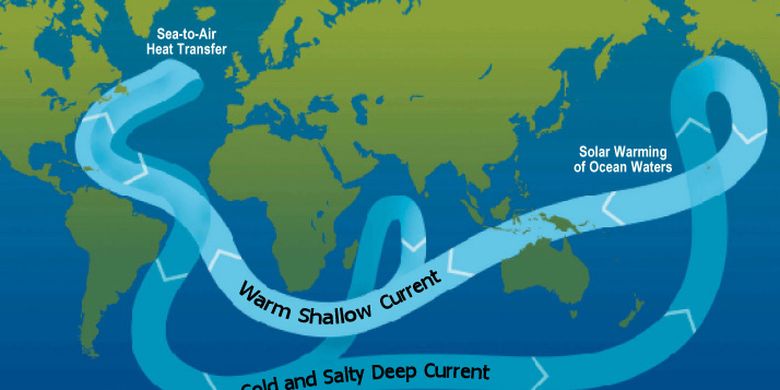KOMPAS.com – Ocean currents move globally in circulation, one of which thermohaline circulation. Thermohaline circulation that pass through Indonesia are generally in the form of currents that are influenced by difference in density of seawater (density).
Definition of thermohaline circulation
The seawater is constantly moving, the surface of the seawater is driven by atmospheric circulation. However, deep in the deep ocean surface also currents move.
Reported from NOAA’s National Ocean Servicethese deep ocean currents are driven by differences in density (density of water, which is controlled by temperature (thermo) and salinity (haline).
Thus, the currents in the oceans on Earth are called the thermohaline circulation.
In simple terms, the thermohaline circulation is an ocean current due to the density of water which is influenced by temperature and also the salinity (salt content) of seawater.
Read also: Ocean Currents: Definition and Factors
Thermohaline circulation is slower than surface current, but has a large scale.
Reported from Encyclopedia Britannicathe thermohaline circulation flows at a rate of 1 centimeter per second, extending to the ocean floor and forming a circulation pattern that envelops the global ocean.
The process of thermohaline circulation
Seawater does not have a homogeneous density. The density of seawater varies according to its salinity (salt content) and temperature.
High salinity with low temperatures makes seawater has a high density. Meanwhile, low salinity with high temperatures makes seawater have a low density.
Read also: Kuroshio Stream: Current Flowing in the Waters of Japan
Atlantic Ocean water density is higher
In the polar regions and the Atlantic Ocean, the density of water is higher. This is due to lower Atlantic temperatures and causes evaporative cooling. Evaporated surface water increases the salinity of seawater and makes it high in density.
Not to mention the formation of polar ice. Polar ice formation mostly just freezes water, while salt will be left behind. This makes the Atlantic Ocean water has a high density.
Pacific Ocean water density is lower
In the Pacific region, solar radiation is higher so the sea water is warmer and floating. The higher temperature makes the Pacific Ocean seawater has a lower density.
Not to mention, in the Pacific the rainfall tends to be high. High rainfall can reduce the salinity of sea water so that its density is also lower than the Atlantic area.
Read also: Marine Elements: Temperature, Color, and Salt Content
Thermohaline circulation occurs
Reported from Lumen Learning, in the Indian Ocean high density water from the Atlantic is drawn in by low density water flows from the Tropical Pacific. Warm water from the Pacific will pass through Indonesia in the thermohaline circulation.
This causes vertical water exchange. Where high density seawater sinks and low density seawater rises to the top.
This density difference creates a slow current movement and is known as the thermohaline circulation.
Despite their slow movement, the thermohaline circulation moves the water column in the Arctic, Atlantic, Indian, and Pacific Oceans, forming a conveyor belt. Thus, the thermohaline circulation is also often referred to as the global conveyor belt.
Get updates news of choice and breaking news every day from Kompas.com. Let’s join the Telegram group “Kompas.com News Update”, how to click the link https://t.me/kompascomupdate, then join. You must first install the Telegram application on your cellphone.–


